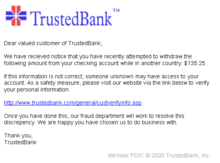A form of social engineering attack that is targeted to victims who have an existing digital relationship with an online entity such as a bank or retail website. A spear phishing message is often an e-mail although there are also text message and VoIP spear phishing attacks as well, which looks exactly like a legitimate communication from a trusted entity. The attack tricks the victim into clicking on a hyperlink to visit a company website only to be re-directed to a false version of the website operated by attackers. The false website will often look and operate similarly to the legitimate site and focus on having the victim provide their logon credentials and potentially other personal identity information such as answers to their security questions, an account number, their social security number, mailing address, email address and/or phone number. The goal of a spear phishing attack is to steal identity information for the purpose of account takeover or identity theft.
Phishing is a form of social engineering where attackers deceive people into revealing sensitive information or installing malware such as ransomware. Phishing attacks have become increasingly sophisticated and often transparently mirror the site being targeted, allowing the attacker to observe everything while the victim is navigating the site, and transverse any additional security boundaries with the victim. As of 2020, it is the most common type of cybercrime, with the FBI's Internet Crime Complaint Centre reporting more incidents of phishing than any other type of computer crime.

The term "phishing" was first recorded in 1995 in the cracking toolkit AOHell, but may have been used earlier in the hacker magazine 2600. It is a variation of fishing and refers to the use of lures to "fish" for sensitive information.
Measures to prevent or reduce the impact of phishing attacks include legislation, user education, public awareness, and technical security measures. The importance of phishing awareness has increased in both personal and professional settings, with phishing attacks among businesses rising from 72% to 86% from 2017 to 2020.


